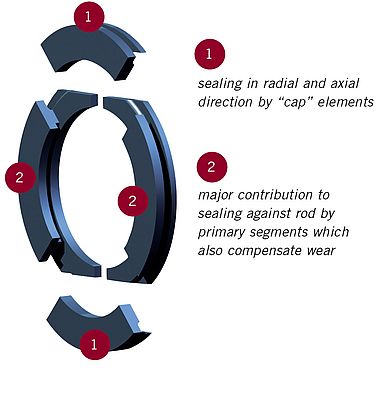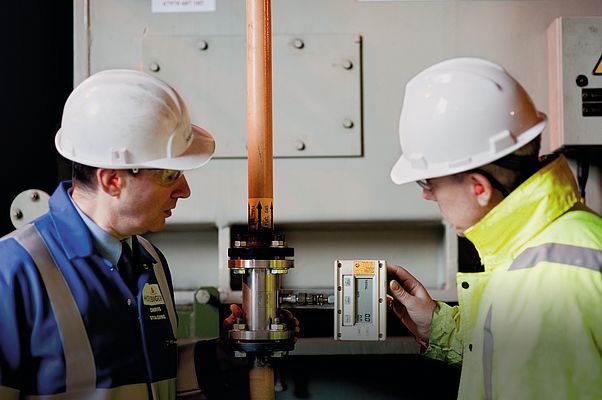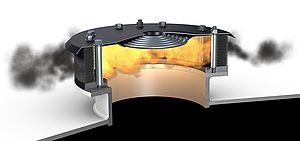Reciprocating compressors are indispensable to the oil, gas and process industries. If they fail or do not perform as required, this has an adverse effect on all the subsequent stages of production.
Reciprocating compressors are used to compress gases. Increasingly, reciprocating compressors are non-lubricated. Not infrequently, the rod seal represents a weak point which leads to comparatively short maintenance intervals. Modern sealing elements which are designed using the finite element method, the so-called BCD rod seals, significantly increase plant availability, even under difficult conditions.
Modern reciprocating compressors are designed to be robust, durable and efficient. However, depending on the execution and environmental conditions, there are specific components which wear out more rapidly. They represent the "hot spots" for maintenance and have a negative impact on the overall economic balance. The rod seal is one of these critical areas.
Until not so long ago, it was impossible to determine the exact thermophysical processes taking place at the sealing ring. The seals were developed purely on the basis of empirical experience, which was often not transferable to new applications. Hoerbiger developed a mathematical model which is used to predict, for each type of compressor, the gas pressure profiles between the sealing ring and rod - the "footprint" of a ring design-, to simulate the breakdown pressure on the packing as well as the temperature profiles on the piston rod, and thus calculate the exact pressure curve, surface pressures and frictional heat generation in advance on a computer.
Based on the new findings obtained from these simulations the easy to install split sealing ring have been developed. Its special geometry takes account of all the pressure influences from static and dynamic loads. Intensive tests on the test rig have confirmed the theoretical results with respect to sealing performance, pressure distribution and frictional behavior.
The design of the BCD rings significantly increases reliability and sealing efficiency: The four ring segments are divided into primary and “cap” elements, each fulfilling different tasks. While the cap elements seal in axial and radial directions, the primary segments seal against the piston rod and form a gap to compensate for wear. This design ensures pressure balancing and guarantees a high level of sealing efficiency over the whole service life.
As a direct result of the favorable pressure distribution between the rings and the piston rod, the contact pressure and thus the friction and heat generation on the ring are also reduced. This contributes towards significantly reducing wear rates and therefore to a longer lifetime, while maintaining a consistently high sealing efficiency. The service life of the new seat is roughly a factor 2 greater than previously. Problems caused by overheating during off-load operation, multiple start-ups, or static leakage are a thing of the past.
The narrow design of the BCD ring means that existing installations can be easily retrofitted. Thanks to its segmented design, the ring can be inserted without having to dismantle the rod, which can be time-consuming. The special design renders the previously standard anti-rotation lock in split rings superfluous. Along with the lower gas leakage during operation and during shutdowns under pressurized conditions, the compressor's environmental performance is significantly improved.
An analysis of the causes of reciprocating compressor failures in the field reveals that the most common cause is valve failures at more than 35%. Packing problems, which make up about 18% of all failures, are the second most common cause. The statistics show that the failure rate could be reduced by simply replacing the packing rings with the rugged BCD rings. This fact is also confirmed by operational data of already upgraded reciprocating compressors. The new BCD rings perform particularly well with natural gas: more and more natural gas compressors are non-lubricated. With conventional solutions, this leads to increased wear.
In a natural gas compressor station, the packing elements failed regularly after 2,000 hours in the first and second non-lubricated compressor stages. By using the HydroCOM stepless control system and replacing the packings for BCD rings, life expectancies of more than 12,000 hours are now possible without leakage. This not only saves maintenance costs, but also dramatically reduces emissions of climate-damaging methane.
The ring design also offers advantages in the process gas industry. For example, one refinery dramatically improved the operating times of its hydrogen compressor. Hydrogen with traces of methane is compressed in two stages to 66 bar, the temperature is approx. 100°C. The previous water-cooled seals operated, non-lubricated, at a piston rod speed of approx. 2.6m/s. The BCD rings were fitted into the existing, cooled packing case. The material of the rings is selected to meet the specific requirements of bone-dry conditions. In continuous operation, with the new sealing rings it was possible to increase the service life to more than 22,000 hours (approx. 2.5 years). This made it possible to extend the regular maintenance of the compressor and to adapt it to that of the other plant components, thus reducing the operating costs for the entire plant.
The sealing rings are optimized for the specific conditions in the compressor by mathematically calculating the actual influences on site. Despite the narrower, split design, the sealing performance and service life are very high, whereas the rod temperature is significantly lower. As an easily retrofittable component, the BCD ring is therefore suitable for all applications where the rod seal previously necessitated a short maintenance interval.



















